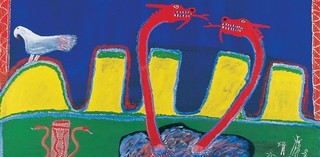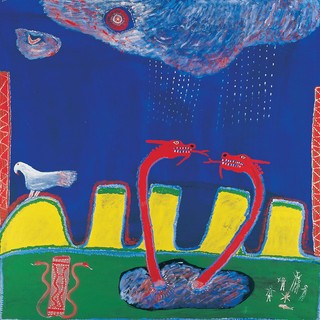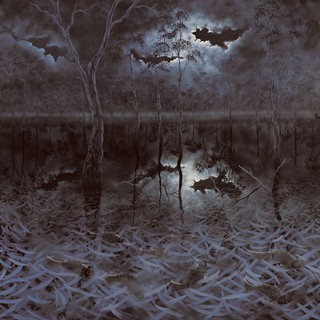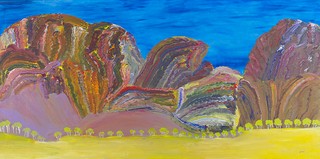Albert Namatjira’s lasting legacy

Ginger Riley Munduwalawala, Australia 1937-2002 / Garimala (The Two Snakes) 1988 / Synthetic polymer paint on canvas / Purchased 1990 with funds from ARCO Coal Australia Inc. through the QAG Foundation / Collection: Queensland Art Gallery | Gallery of Modern Art / © The Estate of Ginger Riley Munduwalawala. Courtesy: Alcaston Gallery, Melbourne / View full image
The life and work of Albert Namatjira have left a lasting legacy for artists throughout the country. As a boy in the 1950s, Ginger Riley Munduwalawala, a Mara painter from the Gulf of Carpentaria, met Albert Namatjira. For many artists, Namatjira’s use of non-traditional colours and techniques was a liberating influence and, when Riley took up painting later in life, his richly toned landscapes, which place his ancestors within their country, were lauded around the world.
Ginger Riley Munduwalawala Garimala (The Two Snakes) 1988

Ginger Riley Munduwalawala, Australia 1937-2002 / Garimala (The Two Snakes) 1988 / Synthetic polymer paint on canvas / Purchased 1990 with funds from ARCO Coal Australia Inc. through the Queensland Art Gallery Foundation / Collection: Queensland Art Gallery / View full image
Lin Onus, a Yorta Yorta artist from Victoria, achieved acclaim for paintings of his country around the Barmah Forest on the Murray River, which combined elements of landscape painting, realism and various Aboriginal painting styles. His references to the landscape painting style were influenced by Aboriginal artists such as Nyoongar artist Revel Cooper and Koori artist Ronald Bull.
Lin Onus Morumbeeja Pitoa (Floods and moonlight) 1993

Lin Onus, Australia 1948-1996 / Morumbeeja Pitoa (Floods and moonlight) 1993 / Oil on canvas / Purchased 1995. QAG Foundation / Collection: Queensland Art Gallery | Gallery of Modern Art / © Lin Onus Estate / View full image
Aboriginal artists from across the country were active in the post-Namatjira period, many of them adopting his style as an Aboriginal painting style before the rise in popularity of the dot painting style in the late 1970s.
Billy Benn Perrurle, an Anmatyerr man from Central Australia, also recalled meeting Albert Namatjira as a boy. Benn was taught by his elder sisters Ally and Gladdy Kemarre to paint on his body in the ‘Utopia’ style, but it was in an expressionistic landscape style that he made his mark. His influences ranged from the Hermannsburg School, whose artists were renowned in the Alice Springs town camps where Benn began making his works, to the Chinese calligraphic traditions taught to him by the Chinese wife of a mica miner.
Kwementyaye Benn Artyetyerre – Harts Range 2008

Kwementyaye Benn, Australia 1943-2012 / Artyetyerre – Harts Range 2008 / Synthetic polymer paint on canvas / Purchased 2008. QAG Foundation / Collection: Queensland Art Gallery | Gallery of Modern Art / © Billy Benn Perrurle/Copyright Agency / View full image
Bruce McLean is former Curator, Indigenous Australian Art, QAGOMA

